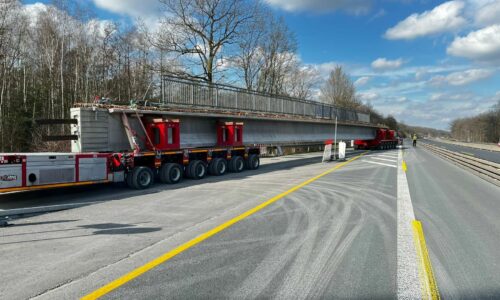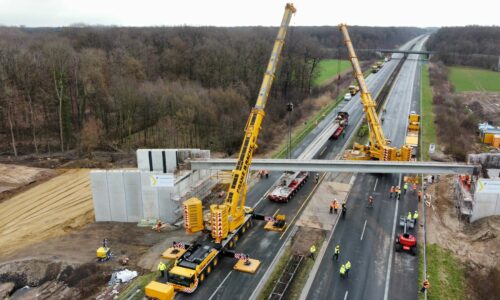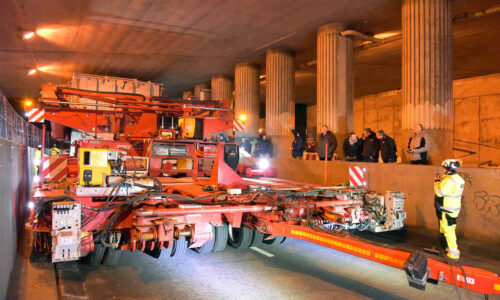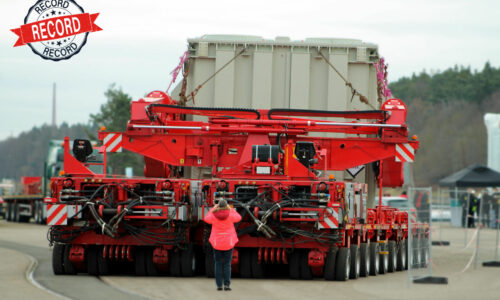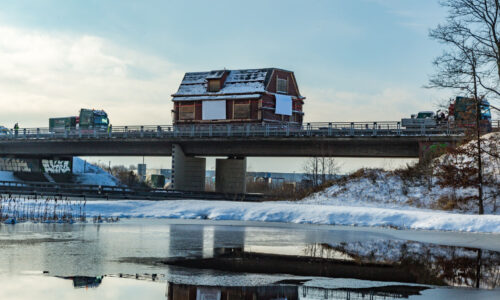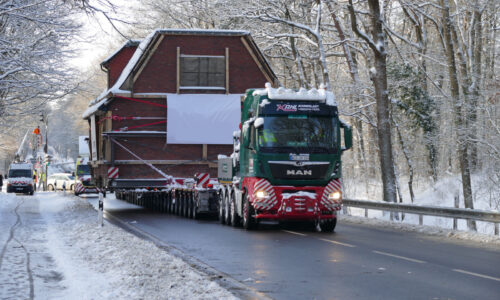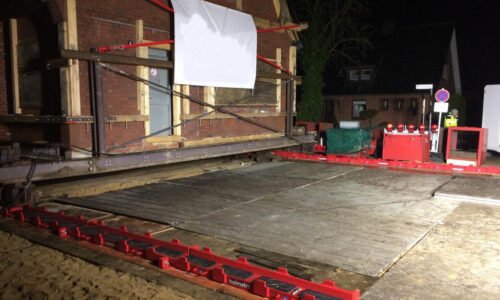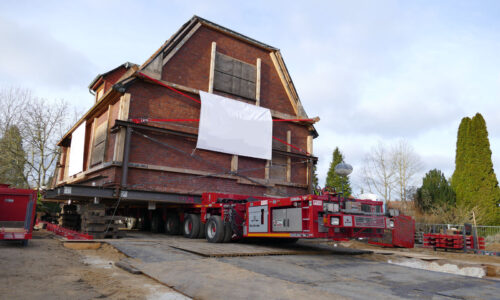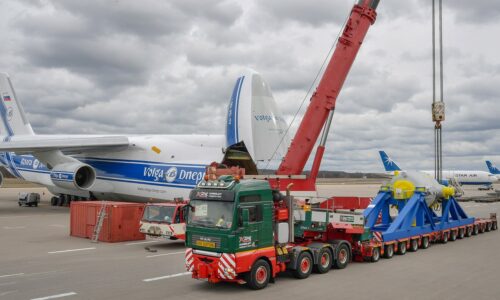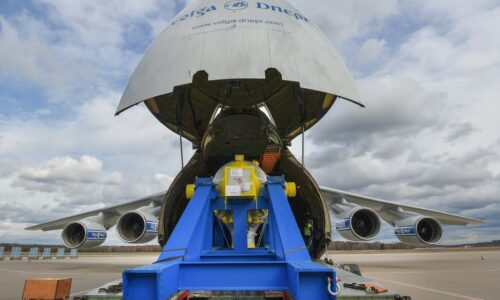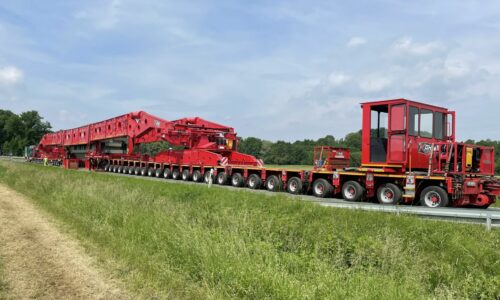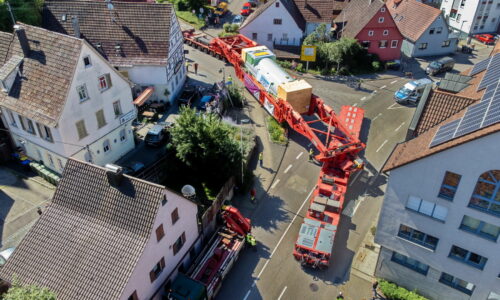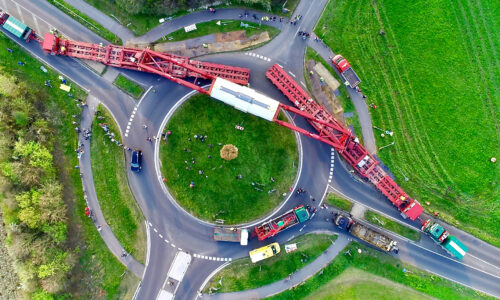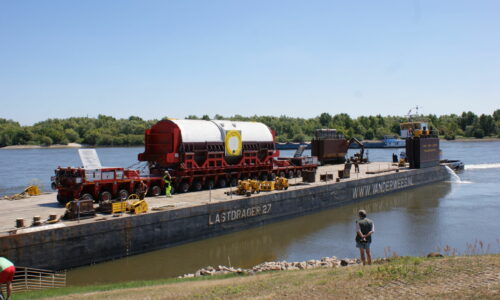PROJECT EXAMPLES
DIMENSION CARGO
7 girder (pretressed concrete bridge)
per girder, 45,69 m l x 1,58 m w x 1,44 m h , 110 tons
OVERALL transport Dimension
61 m l x 3,00 m w x 4,25 m h , 199 tons
Vehicle technology uses
– 6-axle Trailer with 8-axle self-propelled trailers
– 6-axle SPMT (Self-propelled modular transporter)
GERMANY’S LONGEST PRESTRESSED CONCRETE BRIDGE
Delivered safely and on time. Germany’s longest prefabricated prestressed concrete bridge.
The special feature of the new record-breaking structure, the length of 45 metres. This innovative construction method means that the central pier can be dispensed with, which halves the overall construction time.
For this unique structure over the A1 near Ascheberg, we supplied a total of seven girders, each 45 metres long and weighing 110 tonnes each.
We are pleased to have been able to make our contribution to this record-breaking structure and to be working together on the modernisation of the German infrastructure.
DIMENSION CARGO
1 Transformer 1100 kV (World’s most powerful fransformer)
13,35 m l x 6,14 m w x 5,87 m h , 535 tons
OVERALL TRANSPORT DIMENSION
64,30 m l x 7,45 m w x 6,45 m h , 875 tons
VEHICLE TECHNOLOGY USES
– High Girder Bridge G² I K600
– front: 2 power packs with 2 x 10 axle lines SPMT (Self-propelled modular transporter) parralel coupled
-back: 2 x 10 axle lines SPMT (Self-propelled modular transporter) parralel coupled

RECORD TRANSPORT – TRANSPORT OF THE WORLD’S MOST POWERFUL TRANSFORMER
Already 12 months before the largest transformer ever built by Siemens – destined for China – started the first inner-city eight kilometres from the manufacturing plant to the port in Nuremberg, the specialists of the KAHL group of companies became active. The feasibility study commissioned by the customer required various route reconnaissance, elaborate measurements, carefully prepared official procedures and the assurance that suitable transport technology was available. For the enormous transformer with a transmission voltage of 1100 kV, and thus the world’s most powerful converter transformer, weighed in at 535 tonnes with a length of 13.35 m, a width of 6.14m and a height of 5.87m.
Based on load image and CAD simulations (EasyTrack, EasyLoad), the appropriate vehicle configuration was worked out in coordination with the engineering offices involved, which were commissioned with the static recalculations of the total of four bridge structures to be crossed.
Thanks to the innovative equipment of the KAHL group of companies, a vehicle combination could be provided which fulfilled all requirements for this record-breaking transport.
DIMENSION CARGO
1 home,
12 m l x 8,45 m w x 6,50 m h , 200 tons
OVERALL TRANSPORT DIMENSION
55 m l x 8,45 m w x 7,50 m h , 365 tons
VEHICLE TECHNOLOGY USES
22-axle heavy-duty modules
10-axle SPMT (Self-propelled modular transporter)

SIMPLY MOVE WHOLE HOUSES.
The challenge of the customer’s request was to lift a historic 65-year-old settlement house weighing 200 t (dimensions 12 m long, 8.45 m wide and 6.0 m high) from the basement foundation without distortion and in one piece and to move it from its location to the main road in the middle of a housing estate with different street levels, then to transport it over public roads and to place it on the newly constructed foundation at the destination without major interventions in the surroundings. Everything had to be done under the aspect of relocation, with the positioning at the new destination as true to the original as possible. The statics of the transport goods were particularly problematic because of its low stability due to a double wall with air chambers.
MoreDIMENSION CARGO
1 Turbine
14,22 m l x 3,73 m w x 3,57 m h , 115 tons
OVERALL TRANSPORT DIMENSION
1x 4-axle truck
13-axle trailer
ANTONOV LOADING
Road, rail or waterways are usually available for the realisation of large-volume and heavy transports. But when things have to move particularly fast, there is fortunately another option – air freight. Since the 114-tonne turbine and its accessories were needed for an urgent overhaul and had to be delivered within a very narrow time window, there was only one solution – the Antonov An 124-100.
We took over the first section from the manufacturer to Cologne/Bonn Airport with our 13-axle modular chassis, which was pulled by a four-axle tractor. Arriving safely at the airport on schedule, one of the world’s largest aircraft for heavy loads – an Antonov An 124-100 of Volga-Dnepr Airlines – was waiting in the cargo area of the airport. The four-engine shoulder-wing aircraft with an impressive wingspan of over 73 metres was already waiting for its cargo with the nose flap up and the stowage system in place. With a crew of six, it can carry a maximum load of 120 tonnes, bringing its take-off weight to 392 tonnes. The turbine was loaded from our vehicle onto the Antonov’s loading ramp by a mobile crane with a maximum load of 500 tonnes. Pulled by steel cables, the turbine disappeared quite quickly into the large hollow belly of the machine. The load was securely fixed in a precisely defined position to prevent any movement during the flight. With so much weight in the belly, the fuel of the An 124-100 was initially sufficient to reach Athens. From there, after refuelling, it continued to its destination, the airport in Jeddah on the west coast of Saudi Arabia. With its cargo removed, the aircraft returned to Cologne/Bonn to pick up the turbine’s accessories.
DIMENSION CARGO
4 tranformers, each12 m l x 3,98 m w x 4,48 m h , 326 / 307 tons
OVERALL TRANSPORT DIMENSION
112,50 m l x 6,28 m w x 5,55/4,60 h, 742/ 766 tons
VEHICLE TECHNOLOGY USES
– 2x 24 axle lines high girder bridge G² I K600
– 1x 22 axle lines PST/SLE (SPMT/Self-propelled modular transporter)
-Fly-over bridge system

MULTIMODAL TRANSFORMER TRANSPORT
For the extension of the Würgau transformer station, 4 transformers with 326 + 307 t were transported multimodally from the transformer station in A-Weiz via the Danube port of Linz to the transformer station via the port of Bamberg. The pre-carriage was carried out by 32-axle Schnabel wagon (rail) to the heavy goods terminal in Linz, and then by inland waterway vessel to the port of Bamberg. For the unloading from the inland vessel and the subsequent loading into the 2 x 24-axle side girder bridge G² I K 600, we used a 900 t crawler crane. The task was not only to be able to carry the axle load of 12 t for the motorway bridges, but also the required clearance height for the good 4.5 metre high transformers! With a total train length of 112 metres, a width of 6.30 metres and a total train weight of 757 tonnes, it was possible to realise the required axle load of 12 tonnes on the structures by using another 10-axle running gear under the load. For the last part of the route to the transformer station, a reloading onto a 22-axle SPMT was necessary in order to cope with the 9% gradients with the serpentines.
MoreDIMENSION CARGO
1 gas turbine
12 m l x 3,98 m w x 4,48 m h , 338 tons
1 generator
12 m l x 3,98 m w x 4,48 m h , 308 tons
1 transformer
12 m l x 3,98 m w x 4,48 m h , 275 tons
VEHICLE TECHNOLOGY USES
– 22-axle heavy-duty modules(3-file)
– 6 trucks
– 14-axle SPMT (Self-propelled modular transporter)

FUTURE POWER SUPPLY SECURED
For the new construction of the gas-fired power plant Irsching 6, 3 plant components (gas turbine 338 tons, generator 308 tons and transformer 275 tons) had to be transported from the port of Kelheim to Voburg on the Danube.
The project included crane handling at the port, transport to the power plant, transhipment with mast and interim storage with SPMT, as well as subsequent internal transport with SPMT and foundation setting with mobile strand lifting system.
An entire logistics chain with crane, transport and assembly was required here. In addition to the special requirements due to the Corona pandemic (constant checks of all employees and special protection), the power plant operator also placed very high demands on occupational health and safety and environmental protection due to the immediate proximity to the Danube.
MoreDIMENSION CARGO
1 generator, 3,60 m l x 3,25 m w x 3,00 m h , 40 tons
TECHNOLOGY USES
– Push and pull skidding system
– 16 m long steel girders
– Load distribution plates
– 2 heavy-duty towers made of 8 elephant feet
– heavy duty platform
– Working scaffold
– Mobile crane

DISASSEMBLY AND INSTALLATION OF A 40 tons GENERATOR AT VW BAUNATAL
At the VW Baunatal power plant, a 40-tonne generator had failed and needed a general overhaul. We were commissioned with the removal (and later the installation) of the generator.
The special challenges of this installation work lay on the one hand in the insufficient load-bearing capacity of the floor area in front of the Geno, which only allowed 15 kN/m², and on the other hand in the actual removal from the building shell at a height of 9.20 m, only possible by dismantling the outer wall, up to the point of loading.
Due to complicated, time-consuming negotiations with external structural engineers and the customer about the unworkable concept presented by the customer’s structural engineering office, we ran out of time. In the end, our proposed solution prevailed.
With our own shifting track, the hydraulic lifting of the Geno, the substructure of 16m girders, various load distributors and the assembly of a steel construction, we moved the generator from its place to the outside and loaded it with a truck-mounted crane.
DIMENSION CARGO
1 phase shifter, 13.44 m l x 4.13 m w x 4.33 m h , 357 to
OVERALL TRANSPORT DIMENSION
60 m l x 6.40 m w x 6.40 m h, 684 tons
VEHICLE TECHNOLOGY USES
– high girder bridge G² I K600
– 2 x 18 axle lines PST/SLE (SPMT/Self-propelled modular transporter)

GENERATOR- TRANSPORT FOR SECURITY OF SUPPLY
The transport of a rotating phase shifter with a transport weight of 357 t from the Siemens Energy generator plant in Mülheim to Ludwigsburg-Hoheneck to the transformer station of the electricity grid operator Amprion, could only be carried out in a combined logistics chain with inland vessel, 650 t crawler crane for handling and the unique G² I K 600 boiler bridge, combined with 2×18-axle PSTE self-propelled units (SPMT) for the on-carriage.
After completion of the on-carriage, reloading onto a separate 18-axle self-propelled unit was required to bring it into the nacelle. We carried out the unloading with two masts in tandem lift. Extensive preparations, studies and calculations had to be taken into account in advance for the on-carriage from the port to the foundation.
MoreDIMENSION CARGO
1 STATOR
14,68 m l x 4,20 m w x 4,50 m h , 400 tons
VEHICLE TECHNOLOGY USES
– High girder bridge G² I K600
– 2x 26-axle heavy-duty modules
– 2x 14-axle heavy-duty modules
– 2x 14-axle SPMT (Self-propelled modular transporter)
– 2x 10-axle SPMT (Self-propelled modular transporter)


BRAVURA PERFORMANCE IN FIVE VARIANTS
The generators of RWE’s Voerde power plant, which is currently being dismantled, are to be used as a strategic reserve for other locations. We had the task of taking over, removing and transporting the generators, each weighing 400 t, at a height of 13.4 m above the foundation and setting one of the generators down at the Neurath power plant.
This was preceded by almost a year of detailed preparation, including the preparation of CAD assembly and transport simulations, route tests, static calculations, method statements, risk assessments and coordination meetings with representatives of the authorities.
Challenges were the tight space conditions for the deployment in the nacelle, at the Nato ramp for RoRo loading and the restrictions with regard to axle loads and clearance profiles with vehicle dimensions of up to 105 m length x 4.68 m width and 5.70 m height and a total weight of 798 tonnes.
More


